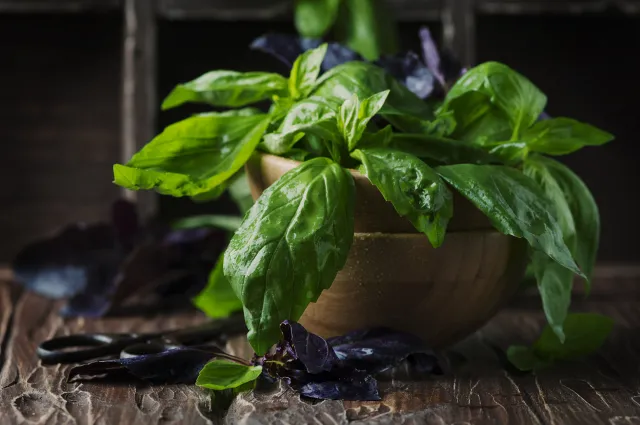
Scientific Name
Ocimum spp.
General Information
Basil is a warm weather annual grown in full sun. The leaves, flowers, and seeds have culinary uses. There are many cultivars, each varying in leaf shape, color, scent, and flavor. Basil grows 8 to 24" tall and 8 to 12" wide, depending on the variety. It is native to Asia and Africa.
When to Plant
From seed: Sow seeds indoors six weeks prior to transplant, March to May. It is not usually seeded directly in the garden.
Transplants: Plant seedlings outdoors April through June when soil is well-warmed and the danger of frost is past. Basil leaves are damaged by temperatures below 40°F.
Cuttings: Basil can be rooted from cuttings. African Blue Basil does not produce viable seeds, so it must be propagated by cuttings taken in the late summer and overwintered in a warm location. Learn more about propagation by cuttings.
Planting
Plant in full sun approximately 12 inches apart. Basil can also be grown indoors near a south-facing window with a minimum of 6 hours of sunlight or fluorescent lights 6 inches above the plants for 14 to 16 hours a day.
Soil Requirements
Grow in richly composted, well-drained soil.
Water Requirements
Keep plants evenly moist.
Fertilizing
Fertilize with fish emulsion when planting and again at mid-season if leaves turn pale.
Pollination
Pollinated by bees.
Harvesting
For leaves, harvest frequently to encourage new growth and to prevent flowers from developing. Pinch off any flowers that do develop. For seeds or for attracting beneficial insects, allow flowers to develop.
Storage
Fresh basil leaves can be stored at temperatures from 50° to 68° F for a short time. For longer-term storage, blanch and then freeze.
Good Varieties for Marin
‘Greek’, ‘Genovese’, ‘Thai Siam Queen’, ‘Pesto Perpetuo’, ‘Lemon’ ‘Tulsi’ also known as Holy Basil), ‘Mammoth’ and disease resistant ‘Nufar’ (a Genovese type hybrid). African Blue and Wild Magic are recent sterile hybrids valued for their beautiful foliage and profuse blooms but not necessarily for culinary appeal. Growing techniques are common for most, although African blue basil is grown as a tender perennial and can be overwintered with care.
Helpful Tips
Regular harvesting and pinch-tipping ensures tasty leaves as flavor decreases when blooms commence.
Common Problems
Aphids (pick or hose them off), whiteflies (hose off), spider mites (hose off), snails (pick them off in early morning) and fusarium wilt (throw infected plant away)
Pests- Diseases & More
Prevent disease in basil with crop rotation, soil solarization and selection of disease resistant varieties. Learn more.


